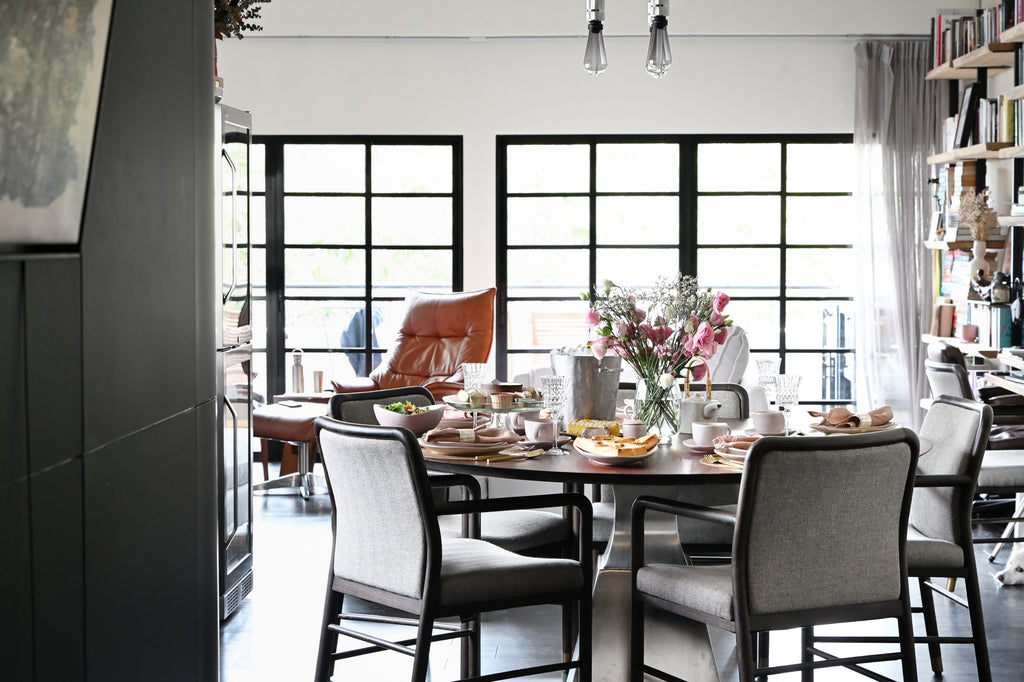The kitchen may be lauded as the heart of the home, but it's the dining table that breathes life into the living space. A stage for countless meals, conversations, and the joyous clink of mealtimes, it carries the essence of every delicious memory forged over shared bites.
Like many homeowners, our personal preference gravitates towards the timeless appeal and craftmanship of wooden dining tables. Having worked with different industry partners, we have since learned that round tables foster intimacy, rectangular tables are excellent at accommodating additional guests, and you need to buffer a minimum of 60cm elbow clearance per pax for comfort. Yet, beyond these foundational functionalities, there’s still much more to consider.
To guide us through this, we’ve enlisted the expertise of our stockist partners, Sam and Darryl of The Table Guy, to help us separate fact from fiction, debunking common misconceptions about wooden dining tables.
 Featured: Sii Chompuu Free-Form Dinner Plate, Satay Free-Form Side Plate, Sii Chompuu Shell Dipping Dish
Featured: Sii Chompuu Free-Form Dinner Plate, Satay Free-Form Side Plate, Sii Chompuu Shell Dipping Dish
True or false: Wooden tables are generally high maintenance.
“False. The care and maintenance required for wooden tables largely depends on the type of finish applied. Opting for a hardwax oil finish, as we do at The Table Guy, ensures stain and heat resistance, making daily use hassle-free and enjoyable (read: you don’t have to fret about every spill!)
At its minimum, caring for your wooden tables involves a prompt and simple wipe with a gentle surface spray, and a soft, clean cloth after use.”
Care tip“Apply a layer of maintenance oil once a year to restore any wear and tear.” |
True or false: Water stains can be removed from a wooden tabletop.
"True, especially with wooden tables from The Table Guy. Wood finishes have a diverse range of seal formulations used to determine breathability, but even the most stubborn watermarks evaporate over time with our hardwax oil seal.
Darker water marks are an indication that the water has penetrated through the finish and into the wood itself (because the wood is wet), whereas white water marks generally indicate that the issue is in the surface layer only, which may be easier to resolve. So depending on the your wood finish, darker marks may be more challenging to remove than white ones. The bright side is: solid wood is always restorable!”
Care tip“Resist the urge to scrub at the stain, and keep the area dry until the mark fades. Scrubbing at any stain (not just water) is equivalent to “sanding” of the surface. Any abrasion to your wood surface will wear out the seal that was used to protect it. The degree of wear and tear will depend on the amount of force used and the abrasive qualities of your tool." |
 Featured: Sii Chompuu Free-Form Dinner Plate, Sii Chompuu Free-Form Side Plate, Bangkok Cutlery Set in Brushed Gold
Featured: Sii Chompuu Free-Form Dinner Plate, Sii Chompuu Free-Form Side Plate, Bangkok Cutlery Set in Brushed Gold
True or false: Ceramics will scratch a wooden tabletop.
“True, ceramic is harder than wood. If dragged across your tabletop with sufficient force, it is likely to leave a scratch. The weight of your dining ceramics also plays a part — smaller plates and cups are less likely to leave a scratch than heftier sharing bowls and serving platters.”
Care tip“Prevent scratches with the use of placemats, that double up as table décor!” |

True or false: Wooden tables with centre leg frames tend to be wobbly.
"False! There are plenty of well-designed centre leg frames that are constructed in consideration of the weight of the tabletop, providing a supportive and study base.”
Design tip“From a general perspective, one way to gauge the stability of a table design is the ratio of floor space taken up by the leg frame, versus the overall space of the table top. There are plenty of well-designed centre leg frames that are constructed in consideration of the weight of the tabletop, providing a supportive and study base. We generally aim to have a maximum of 200mm overhang (unsupported weight) for the table top.” |
True or false: Wooden tables can be used in covered balconies or patios.
“True, with a few caveats. Direct sun and rain exposure can wear away the seal on your wooden table, weakening its fibres and leading to potential flaking and splits over time. While it is unlikely that your outdoor wooden table will fall apart, it requires additional care and maintenance. This frequency of maintenance depends largely on the outdoor exposure of your surroundings and the location where you’re placing your table. For example, a patio surrounded by high rise buildings is less likely to suffer rain and sun damage than a balcony with a sea view.”
Care tip“Consider implementing solar films or a blind system to minimise exposure of rain and sunlight.” |


Shop a selection of KRA Sanctuary dining ceramics in person at The Table Guy
221 Henderson Rd, #01-06A, Singapore 159557
Opens Thurs - Sun, 11am - 6pm

